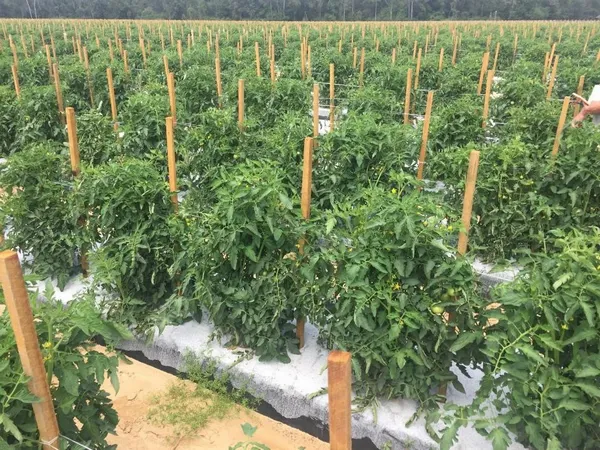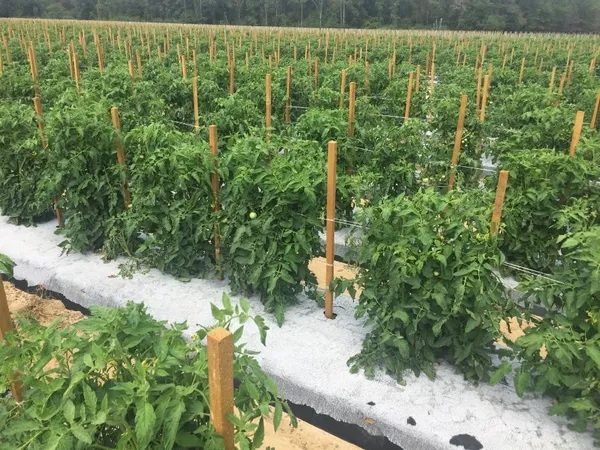 For years, growing tomatoes in the states of Florida and Georgia has been complicated by the Tomato Yellow Leaf Curl Virus (TYLCV). The virus is transmitted exclusively by the silverleaf whitefly.
For years, growing tomatoes in the states of Florida and Georgia has been complicated by the Tomato Yellow Leaf Curl Virus (TYLCV). The virus is transmitted exclusively by the silverleaf whitefly.
“During times when whitefly populations are difficult to control, in-field spread occurs at a very rapid rate,” says Dr. Randy Johnson, Pathologist and Station Manager with Sakata Seed America. “If infection occurs before fruit set in susceptible varieties, the plant will become stunted and distorted in growth and flowers are usually aborted, resulting in no yield. If virus transmission occurs after fruit set, quality and aesthetics can be compromised depending on the timing of infection and growing conditions,” he added.
 Sakata's Grand Marshall tomato variety in a field in Georgia.
Sakata's Grand Marshall tomato variety in a field in Georgia.
Mild winters
This year in particular, the virus seems to hit tomato plants in Florida and Southern Georgia hard. “Many parts of these states can go several years without a significant freeze or a wet weather event like a hurricane, allowing the whitefly population to grow,” said Johnson. Whiteflies are relatively delicate insects that do not survive well in wet and/or cold conditions. “However, the recent mild winters have been extremely conducive for the virus and haven’t been able to break the disease cycle.”
In addition to weather circumstances, Johnson notices that the virus is most destructive in regions with overlapping production windows. In South Florida, fall production may have low disease pressure, but as more production areas overlap throughout winter and into spring, the virus infection curve ramps up. “Ultimately, it could approach 100 percent total loss if the whitefly population builds to levels that cannot be controlled.”
 TYLCV is also challenging outside the United States. “The virus has many strains worldwide and has a significant global impact,” says Bryan Zingel, Senior Product Manager with Sakata. It can be devastating particularly in seasons and slots that are relatively dry. TYLCV is considered one of the major virus challenges on all continents where tomatoes are commercially produced.
TYLCV is also challenging outside the United States. “The virus has many strains worldwide and has a significant global impact,” says Bryan Zingel, Senior Product Manager with Sakata. It can be devastating particularly in seasons and slots that are relatively dry. TYLCV is considered one of the major virus challenges on all continents where tomatoes are commercially produced.
Disease resistance is critical factor Back to North America, “the virus has the potential to get much worse when the tomato industry transitions its production from South Florida into North Florida and Georgia,” says James Galante, Sakata’s Area Sales Manager Florida. “Strong resistance in variety selection is a critical factor,” he added. “Plants with good resistance for TYLCV should recover from the disease and be productive, although yields may be partially affected,” continued David Wolff, Senior Tomato
Back to North America, “the virus has the potential to get much worse when the tomato industry transitions its production from South Florida into North Florida and Georgia,” says James Galante, Sakata’s Area Sales Manager Florida. “Strong resistance in variety selection is a critical factor,” he added. “Plants with good resistance for TYLCV should recover from the disease and be productive, although yields may be partially affected,” continued David Wolff, Senior Tomato  Breeder with Sakata Seed. “Even if the disease hits young plants that have resistance genes, they can still show significant symptoms early, but grow out of them. Performance of tomato plants hit by TYLCV depends greatly on the resistance genes used and genetic background of the hybrid varieties.”
Breeder with Sakata Seed. “Even if the disease hits young plants that have resistance genes, they can still show significant symptoms early, but grow out of them. Performance of tomato plants hit by TYLCV depends greatly on the resistance genes used and genetic background of the hybrid varieties.”
Varieties that meet all requirements
For more than 20 years, Sakata has been putting great effort in breeding tomato varieties that are not only resistant to TYLCV, but also provide the yield, fruit size and quality that growers need. “It is our goal to offer a complete portfolio of not only high-quality disease resistant varieties, but to also make sure these varieties have all the necessary traits needed to meet and exceed the market’s demand,” said Galante.
“We offer varieties that can minimize risk and exposure to potential losses caused by TYLCV for different growing regions and growing periods,” shared Zingel. “All our varieties that claim intermediate resistance to TYLCV targeting the United States east coast have been tested in the respective regions and sowing slots.”
 Red Snapper tomatoes in Georgia.
Red Snapper tomatoes in Georgia.
Sakata’s broad portfolio of varieties can be accessed here. Galante discusses some varieties that stand out. “In the past three years, the variety Grand Marshall was brought to market, offering good opportunities and performance for growers in North Florida and the entire Southeastern part of the US. “This variety has shown consistent high levels of resistance in grower fields, university trials as well as our own internal trials,” commented Wolff. “We are very confident in its performance under disease pressure and other stresses such as high temperature.”
The relatively new and TYLCV-intermediate resistant varieties Red Snapper and STM2255 perform well from South Florida all the way through into the Northeastern US. “Both of these varieties bring confidence and security to the Southeast grower base. We want the tomato grower community to know that we are committed to hearing their need and responding with quality,” finished Galante.
For more information:
James Galante
Sakata Seed America
Tel: (+1) 239-243-5952
jgalante@sakata.com
www.sakata.com
